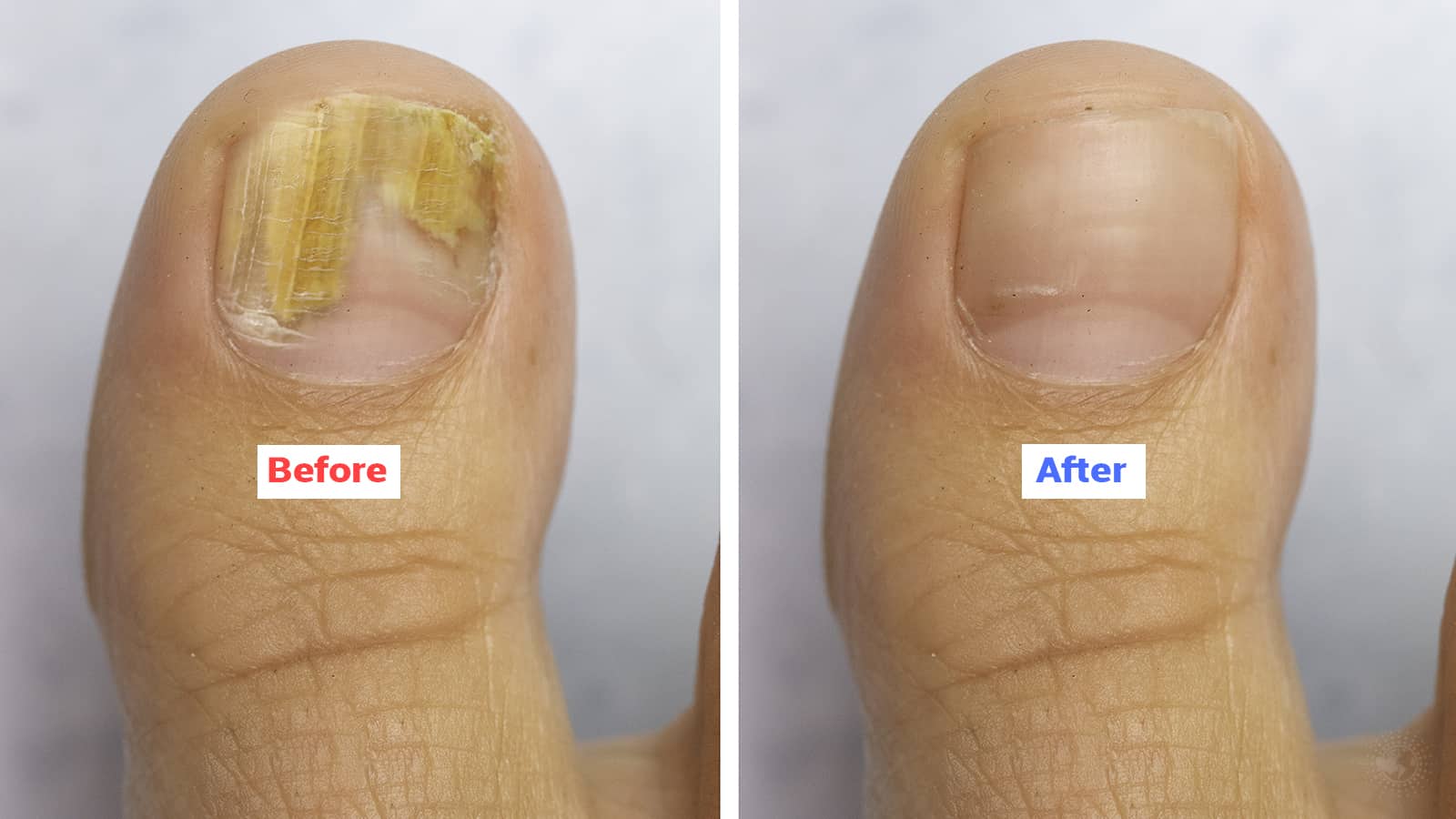Do you or someone you love suffer from nail fungus? It’s a common problem that can happen to anyone, but a few individuals are at a higher risk than others. Did you know that your age, health, and lifestyle can all affect whether you will develop those unsightly, thickened surface yellow nailbeds?
What Causes Nail Fungus?
Many things can cause nail fungus, but it all starts from fungi that get into the nailbeds and fester. Tiny, microscopic organisms called fungi cause an infection in the nail that multiplies. Commonly, a condition such as ringworm or athlete’s foot introduces fungi to the nail.
Still, skin-to-skin contact with other contaminants or someone infected can cause this unsightly problem. Places like locker rooms, saunas, or a pool decks are also loaded with fungi; they love to dwell in moist areas. Walking across a public pool deck barefoot may be all it takes to introduce fungi to your nails.
You can pick up this infection from a pair of finger or toenail clippers or even a bath towel in the household. Another shocking thing is that you can develop this fungus even if you haven’t been exposed. The feet of someone who wears socks and shoes are regularly subjected to moisture from sweat, and it’s easy for fungi to thrive in such an environment.
How does the fungus make the leap from the skin to the nail? Here are a few ways to consider:
- Cuts or abrasions surrounding the nailbeds
- Cracks or tears in the nail
- A space or separation between the toe or finger and the nail
Underneath the nail is nice and warm because the body is nearly 99 degrees. The infection can establish residence there as it’s the perfect breeding ground to live and thrive. Once it grows here, it will move and spread to other areas of the body.
When the infection starts, it’s easier to catch as it sits near the nail’s surface. However, as the fungi spread, it becomes much more complicated.
Who Gets Nail Fungus?
 We’ve already established that anyone can develop a nail fungus, but some people have a higher risk of infection. As you age, the chances of you developing such an infection increase. Children are the least common people to get such a condition, especially before six.
We’ve already established that anyone can develop a nail fungus, but some people have a higher risk of infection. As you age, the chances of you developing such an infection increase. Children are the least common people to get such a condition, especially before six.
People who live in hot and humid climates have an increased risk of infection due to their living environment. Your medical situation also plays a big part in whether such a fungus can thrive on your body. Those who have the following conditions are more susceptible:
- Type 2 Diabetes
- Circulation Issues
- Psoriasis
- HIV – Human Immunodeficiency Syndrome
- Weakened Immune System
- Organ Transplant Recipient
- Injured Toenail or Fingernail
- Athlete’s Foot
- Cancer
- Recent Nail Infections
- Those Who Sweat Heavily
- Those Who Frequent Gyms, Spas, or Swimming Pools
Symptoms of a Nail Fungus
The most common sign of a fungus of the nail is a thickened surface. Here are some other symptoms in the nails:
- Yellow or brown discoloration
- Crumbly or brittle nails
- Foul smell
- Shape distortion
- Debris building under the nail
- Dark coloring
- Impossible to cut with clippers because it’s too thick
Fungus on the nails is quite common. It often starts as a white spot under the nail, an annoyance more than anything else. However, as the infection grows and penetrates, it will turn colors, become thicker, and crumble. What started as a fungus affecting one nail can quickly spread to other toes or fingernails.
Some mild conditions that are troublesome may not require treatment. However, you can do home-based therapies when the nail becomes thick, turns colors, or smells foul. Remember that even if your efforts are successful, the fungus can return.
The same fungus that gets between the toes and causes athlete’s foot is called tinea pedis, and it’s not the same as onychomycosis or nail fungi, but having this infection in between the toes can undoubtedly spread to the nails if there is an opening that allows it to creep in.
Difficulties with Nail Infections
While many cases of fungus are mild, some become complicated. When issues are severe, the toxins can cause permanent damage to the nail, and you may lose it. The goal is to keep the infection from spreading to other body areas beyond the feet.
The biggest concern is those with a compromised immune system, which can be dangerous if the infection gets out of control. Those with Type 2 diabetes can often have circulation issues too that affect their feet. This puts you at a greater risk of developing a bacterial skin infection like cellulitis, which can be dangerous.
With diabetes, any infection that affects your feet can be a severe complication requiring prompt medical help. While most don’t need to be concerned if there is a small dot of yellow or white under the nail, for the diabetic, it’s a cause for alarm.
Preventing Toenail Infections
Prevention is the key to keeping nail fungus at bay. You can reduce the risk of developing such a condition by doing the following things.
- Wash your feet every day. Scrub them several times if they are prone to excessive sweat.
- Wash your hands frequently and wash them, especially after touching your feet.
- Wear shoes that allow your feet to breathe so no moisture builds up inside the footwear.
- Always wear shoes in locker rooms, pool decks, and saunas.
- Avoid using artificial nails and going to public salons for such treatments.
- Don’t paint toe or fingernails as it traps bacteria.
- Don’t keep old shoes that smell and have soles missing.
- Buy sweat-absorbing socks that can keep your feet dry or change your socks a couple of times each day to prevent moisture build-up.
- Trim your nails straight across and never cut to a curve.
- File down any thickened areas of your nails before it becomes unmanageable.
- Always clean all toenail and fingernail clippers with soap and water after each use.
Home Remedies and Treatments for Nail Fungus
Not every case of fungus requires a trip to the doctor. You can do many treatments at home to handle the situation. Here are the most common treatments–they’re at least worth a try.
1. Tea Tree Oil
Make sure you use a pure 100 percent essential tea tree oil. Rub the nail directly with the oil and allow it to dry before putting on socks or shoes. Repeat often as this oil is known for its antifungal and antibacterial properties.
2. Olive Leaf Extract
Apply olive leaf extract directly to the nail, allowing it to do its magic. It has a property called oleuropein that can help it to eat away at the unsightly toxins.
3. Listerine
Did you know that Listerine was first created in the 1800s to keep surgeries clean? It was invented by Dr. Joseph Lawrence, who wanted to help control germs during surgical procedures at his clinic.
After some trial and error, they found that it would also do wonders for the mouth’s bacteria. However, you needed a prescription to obtain it. Today, you don’t need a prescription for this tonic, and a foot soak in this potent brew is just what you need to get rid of the nasty fungus. Only dilute it in water and soak your feet for up to fifteen minutes.
4. Vicks VapoRub
Do you remember your mom or grandma using Vicks VapoRub for many things? Well, they were smart to use this stuff for anything from sore throats to skin issues. Just rub some Vicks VapoRub on your affected nails and watch it work magic. It turns out that this product has camphor and eucalyptus oil, which is known to have a positive effect on nail fungi.
5. Snakeroot Extract
If you have a stubborn infection, you may want to try some Snakeroot extract. It’s a plant related to the sunflower, and it’s known for its antibacterial properties. If you’ve tried some of the other commonly found methods and they haven’t helped, then you may want to order some of this extract to try.
6. Olive Leaf Extract
Olives and their leaves are both known for their medicinal properties. With this herb, you can either use the capsules that heal your body from the inside out or apply the mixture to your feet. The immune-boosting abilities of this plant and the antifungal and antimicrobial benefits cannot be denied.
7. Vinegar
You can use vinegar for cooking and cleaning your house, but did you know it works great for removing fungus? Get a tub and put one-third vinegar to two-thirds water. Warm water is advisable since it helps open pores and allow the mixture to penetrate. Soak for about twenty minutes each day until you see an improvement.
 Final Thoughts on Ridding Yourself of Embarrassing Nail Fungus
Final Thoughts on Ridding Yourself of Embarrassing Nail Fungus
Having nail fungus is no fun, especially when you want to wear sandals and flip-flops in the summer. Thankfully, most cases can be treated with a home remedy. However, if you’ve tried several alternative medicines and nothing works, you need to see your dermatologist. A nail fungus could reveal a more serious underlying concern, so seek treatment if these remedies don’t work.


















